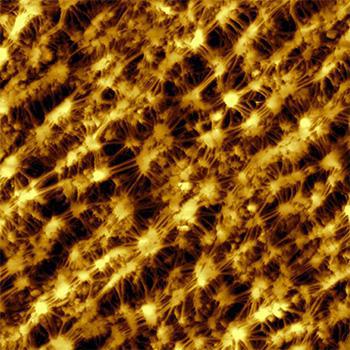The abbreviation ePTFE stands for expanded polytetrafluorethylene, also known as expanded Teflon. The mechanical and medical properties of the material depend strongly on how the Teflon was expanded (mono- or bi-axially) and on the resulting ePTFE network structures. Due to its inert properties inside a human body, ePTFE is often used as an implant material. The empty spaces inside the network structure encourage the growth of soft tissue into such implants, which helps hold the implant in place quickly. There are many different ways to expand PTFE, all leading to different network structures. It is therefore very important to verify that the desired ePTFE structure was obtained after the expansion process.

In this application note, we analyzed an ePTFE membrane using AFM. The topography image recorded clearly shows the intricate network structure of the sample. The length of the fibers and the size-distribution of the knots can conveniently be analyzed using the measurement tools integrated in the Nanosurf control software.
Compared to the conventional method used for this analysis - SEM imaging, where a gold film must first be evaporated onto the ePTFE sample in vacuum to make it conductive - AFM is much faster and easier to perform. With the AFM, ePTFE can be measured directly, without any prior treatment of the sample. Additionally, and in contrast to the SEM data, the AFM topographs actually contain quantitative depth information.

